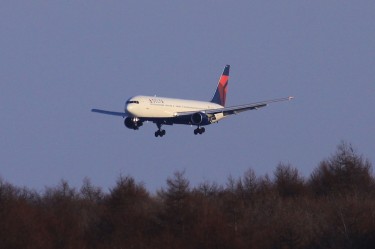On March 11, 2011, a Delta airplane pilot approaching Tokyo airport described his experience of an emergency landing in an e-mail (see below). It was such a vivid description that his record rapidly spread across the blogosphere.
Here is an excerpt:
Suddenly ATC comes up and gives us a vector to a fix well short of Chitose and tells us to standby for holding instructions. Nightmare realized. Situation rapidly deteriorating. After initially holding near Tokyo, starting a divert to Nagoya, reversing course back to Tokyo then to re-diverting north toward Misawa, all that happy fuel reserve that I had was vaporizing fast. My subsequent conversation, paraphrased of course…., went something like this:
“Sapporo Control – Delta XX requesting immediate clearance direct to Chitose, minimum fuel, unable hold.”
“Negative Ghost-Rider, the Pattern is full” < << top gun quote <<<
“Sapporo Control – make that – Delta XX declaring emergency, low fuel, proceeding direct Chitose”
“Roger Delta XX, understood, you are cleared direct to Chitose, contact Chitose approach….etc….”Enough was enough, I had decided to preempt actually running critically low on fuel while in another indefinite holding pattern, especially after bypassing Misawa, and played my last ace…declaring an emergency. The problem with that is now I have a bit of company paperwork to do but what the heck.
As it was – landed Chitose, safe, with at least 30 minutes of fuel remaining before reaching a “true” fuel emergency situation. That's always a good feeling, being safe. They taxied us off to some remote parking area where we shut down and watched a half dozen or more other airplanes come streaming in. In the end, Delta had two 747s, my 767 and another 767 and a 777 all on the ramp at Chitose. We saw to American airlines planes, a United and two Air Canada as well. Not to mention several extra All Nippon and Japan Air Lines planes.Post-script – 9 hours later, Japan air lines finally got around to getting a boarding ladder to the plane where we were able to get off and clear customs. – that however, is another interesting story.
The meme was translated into other languages, and an aviation fan BUTA_NEKO responded to the meme [ja] on his blog in Japanese, to tell the other side of the story. It so happened that he was at New Chitose Airport at the same time as the Delta’s emergency landing, taking photos and listening to the airband radio.
This post has been partially translated with the blogger's permission.
このパイロットの記述に関し、大いに理解はするし心情も察するが、3月13日に『新千歳空港 ダイバート』という記事を掲示した様に 偶然だが、その時千歳にいて写真を撮りながら航空無線を聞いていた者として いくつか気になった点に関して補足させておいて頂きたいと思う。
が、先にお断りしておくけれども 私はこの手記の筆者であるパイロットに文句を言いたいのでは無い それと、空の上も大変だったろうけれども、空の下にも事情があって大変だった事を併せて読者に御理解を願いたいのだ。
He starts by examining this conversation:
“Sapporo Control – Delta XX requesting immediate clearance direct to Chitose, minimum fuel, unable hold.”
“Negative Ghost-Rider, the Pattern is full”
このやりとりがされた時の新千歳空港は いくつかの事情で混乱していたのだ。
それは、有感地震が発生すると 新千歳に限らず、どこの空港でもランウェイ・クローズ(一時的に空港閉鎖を宣言して離着陸を禁止する)して ランウェイ・チェック(滑走路に亀裂など問題が発生していないか確認する作業)を行う。
ランウェイ・チェックにより閉鎖される時間は5~10分だが、新千歳空港の民航機の離発着量では そんな僅かな時間でも数機が着陸待機を命じられ この時は北風だったからポイント・ムカワでホールド(旋回待機)となる。
At this time, there were a few things going on at New Chitose Airport that was causing confusion. Once a noticeable quake happens, airports normally close their runways. This means declaring the airport as temporarily closed and prohibiting landings and take-offs to check if there are defects such as runway cracks.
This check may take five to ten minutes but considering the amount of Chitose’s civil aviation, it means that several civil aircrafts will be ordered to delay their landings. Those aircrafts had to hold at Point Mukawa against the northern wind at that time.
ランウェイチェックに要する時間を含めて、滑走路に問題がない事が確認されれば、普通であれば30分ぐらいで旋回待機していた機体はすべて着陸し いつもの何事もない新千歳空港に戻れたはずなのだが、この時は 私が知っているだけでも本震の他に3回の結構な揺れの余震が それも間の悪い事に地震-ランウェイチェック-地震-ランウェイチェックという様なタイミングが繰り返され 大凡だが、1時間近くランウェイ・クローズ状態が続いたから それだけで、相当な数の旋回待機状態の民航機が苫小牧以南の太平洋上におり、それらの中にも「燃料が残り少ない…」と訴える機が数機生じており、さらにその中の千歳をよく知るのであろうパイロットの一人は「ランウェイ01(民間側)ではなく、36(自衛隊側)もダメですか?」と、通常では考えられない事を聞いてくる者もいたぐらいに切迫していたのだ。
第2に 新千歳と呼ばれる民間側とは別に隣接した千歳基地側の滑走路では
「規模が大きい津波が接近しているようだ」
と、通常は領空侵犯対処の為に待機しているF-15が4機 それぞれ別個の海岸線を津波や被害の確認にスクランブルしたり、T-4や救難隊のU-125も上がり 海上保安庁も同様。

Delta's B767 approaching New Chitose Airport. Licensed under CC-BY by BUTA_NEKO
上の写真は 3月11日のまさにその記事のデルタ航空の767が千歳に着陸するところを撮影したもの
この機体が着陸してきたのは写真の撮影時間を見ると16時42分 記憶に間違いがなければエマジェンシー云々のやりとりが無線でなされていたのは16時前後だったと思う。
11日14時46分頃 三陸沖 震度7
11日15時06分頃 三陸沖 震度5弱
11日15時15分頃 茨城県沖 震度6弱
11日15時26分頃 三陸沖 震度5強
15時から15時半頃には東北沿岸に津波は到達していた…という時系列を念頭に置いていただければ御理解頂けると思う。
Tremor timeline is described as:
(Seismic) Scale 7 at 2:46 pm, Mar 11, centered off the coast of Sanriku
Scale 5-lower at 3:06 pm, Mar 11, centered off the coast of Sanriku
Scale 6-lower at 3:15 pm, Mar 11, centered off the coast of Ibaraki
Scale 5-upper at 3:26 pm, Mar 11, centered off the coast of Sanriku
Also, tsunamis reached Tohoku coasts between 3:00 and 3:30 pm. This timeline helps to comprehend the situation.
ゆえに、『本当の緊急事態になるまで30分の燃料を残していたが、』という一文を 他の航空機も含めて無事に何事も起きずに終わった今となっては ある意味「それは良かったね」と看過すべきなんだろうとは思うが、あの時の管制官達の置かれた状況と奮闘を思うと「なんだそれ?」って気さえ若干ではあるがする。
Thirdly, he examines this portion: “9 hours later, Japan air lines finally got around to getting a boarding ladder to the plane where we were able to get off and clear customs.”
この文だけ読むと あたかも「管制塔の指示で9時間待たされた…」という風に読む側には受け取れるが、それは違う。
着陸した時点で 本来の目的地である「成田」には直ぐに行けないと判断した機(例えば、アメリカンやエア・カナダのそれぞれ1機ずつ)は 比較的早くに乗客を降ろしていた。想像も含めて言わせて貰えば とりあえず給油だけ済まし、成田がランウェイ・オープンするようであれば即離陸しよう…という風に考え様子見をしていた機は その後、続々と降りてきた国内線の定期便が 特に羽田や成田の滑走路閉鎖に伴い折り返し便が欠航となった事もあって それらの機体のスポット移動などが混乱し待たされたのである。
Flights that were deemed not possible in reaching their original destination of Narita Airport (for example, an American Airlines flight and an Air Canada flight) were actually able to get their passengers to the ground relatively quickly.
I would venture to say that many of these aircrafts were hoping to refuel and take off as soon as Narita opened their runways. However, domestic flights started landing at Chitose one after the other, especially after runways at Haneda and Narita closed down and return flights were canceled. Spot reassignments of these crafts caused confusion and a long wait time.
それと、慣れない空港に降りたためか 国際線ターミナルに向かうタクシーウェイ上でしばらく立ち往生の様にとどまっていた某外国航空会社の機体が もしかしたら混乱に拍車をかけていた様な気さえもする。で、重ねて申し上げておくが 私はこのパイロットの手記を非難したいのでは無いし、怒って記しているわけでも決して無い。たまたまだが、偶然にその場に居合わせたマニアの一人として ちょっとだけ記してみたいと思っただけなのだ。







1 comment
What a coincidence he was there. It sounds like Japan Inc. won’t decloak its massive and invasive surveillance system – they probably could discern where live bodies were buried beneath the rubble – but a foreigner’s blog post can definitely lure them into peeking out … just a little. They can’t resist. It’s their psychology – like Adele getting heart played with. Japan, you’re ADELE – rolling in the deeeeeeeeeeeeeeeeeeeeeeeeeeeeeeeeeee -eeeeeeeeeeeeeeeeeee -eeeeeeeeeeep!
such a simple and inexpensive but effective lure to get the big fish to show his location, tsk, tsk.
Cool.